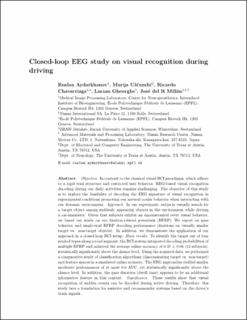Please use this identifier to cite or link to this item:
https://doi.org/10.21256/zhaw-22244Full metadata record
| DC Field | Value | Language |
|---|---|---|
| dc.contributor.author | Aydarkhanov, Ruslan | - |
| dc.contributor.author | Ušćumlić, Marija | - |
| dc.contributor.author | Chavarriaga, Ricardo | - |
| dc.contributor.author | Gheorghe, Lucian | - |
| dc.contributor.author | Millán, José del R | - |
| dc.date.accessioned | 2021-04-09T09:59:39Z | - |
| dc.date.available | 2021-04-09T09:59:39Z | - |
| dc.date.issued | 2021 | - |
| dc.identifier.issn | 1741-2552 | de_CH |
| dc.identifier.issn | 1741-2560 | de_CH |
| dc.identifier.uri | https://digitalcollection.zhaw.ch/handle/11475/22244 | - |
| dc.description.abstract | Objective. In contrast to the classical visual brain–computer interface (BCI) paradigms, which adhere to a rigid trial structure and restricted user behavior, electroencephalogram (EEG)-based visual recognition decoding during our daily activities remains challenging. The objective of this study is to explore the feasibility of decoding the EEG signature of visual recognition in experimental conditions promoting our natural ocular behavior when interacting with our dynamic environment. Approach. In our experiment, subjects visually search for a target object among suddenly appearing objects in the environment while driving a car-simulator. Given that subjects exhibit an unconstrained overt visual behavior, we based our study on eye fixation-related potentials (EFRPs). We report on gaze behavior and single-trial EFRP decoding performance (fixations on visually similar target vs. non-target objects). In addition, we demonstrate the application of our approach in a closed-loop BCI setup. Main results. To identify the target out of four symbol types along a road segment, the BCI system integrated decoding probabilities of multiple EFRP and achieved the average online accuracy of 0.37 ± 0.06 (12 subjects), statistically significantly above the chance level. Using the acquired data, we performed a comparative study of classification algorithms (discriminating target vs. non-target) and feature spaces in a simulated online scenario. The EEG approaches yielded similar moderate performances of at most 0.6 AUC, yet statistically significantly above the chance level. In addition, the gaze duration (dwell time) appears to be an additional informative feature in this context. Significance. These results show that visual recognition of sudden events can be decoded during active driving. Therefore, this study lays a foundation for assistive and recommender systems based on the driver's brain signals. | de_CH |
| dc.language.iso | en | de_CH |
| dc.publisher | IOP Publishing | de_CH |
| dc.relation.ispartof | Journal of Neural Engineering | de_CH |
| dc.rights | Licence according to publishing contract | de_CH |
| dc.subject | Brain-computer interface | de_CH |
| dc.subject | Driving | de_CH |
| dc.subject | Electroencephalography | de_CH |
| dc.subject | Eye tracking | de_CH |
| dc.subject | Visual recognition | de_CH |
| dc.subject.ddc | 150: Psychologie | de_CH |
| dc.title | Closed-loop EEG study on visual recognition during driving | de_CH |
| dc.type | Beitrag in wissenschaftlicher Zeitschrift | de_CH |
| dcterms.type | Text | de_CH |
| zhaw.departement | School of Engineering | de_CH |
| zhaw.organisationalunit | Institut für Informatik (InIT) | de_CH |
| dc.identifier.doi | 10.1088/1741-2552/abdfb2 | de_CH |
| dc.identifier.doi | 10.21256/zhaw-22244 | - |
| dc.identifier.pmid | 33494072 | de_CH |
| zhaw.funding.eu | No | de_CH |
| zhaw.issue | 2 | de_CH |
| zhaw.originated.zhaw | Yes | de_CH |
| zhaw.pages.start | 026010 | de_CH |
| zhaw.publication.status | acceptedVersion | de_CH |
| zhaw.volume | 18 | de_CH |
| zhaw.embargo.end | 2022-02-26 | de_CH |
| zhaw.publication.review | Peer review (Publikation) | de_CH |
| zhaw.webfeed | Datalab | de_CH |
| zhaw.webfeed | Information Engineering | de_CH |
| zhaw.webfeed | Machine Perception and Cognition | de_CH |
| zhaw.author.additional | No | de_CH |
| zhaw.display.portrait | Yes | de_CH |
| Appears in collections: | Publikationen School of Engineering | |
Files in This Item:
| File | Description | Size | Format | |
|---|---|---|---|---|
| 2021_Aydarkhanov-etal_Closed-loop-EEG-study-visual-recognition-driving.pdf | Accepted Version | 3.29 MB | Adobe PDF |  View/Open |
Show simple item record
Aydarkhanov, R., Ušćumlić, M., Chavarriaga, R., Gheorghe, L., & Millán, J. d. R. (2021). Closed-loop EEG study on visual recognition during driving. Journal of Neural Engineering, 18(2), 26010. https://doi.org/10.1088/1741-2552/abdfb2
Aydarkhanov, R. et al. (2021) ‘Closed-loop EEG study on visual recognition during driving’, Journal of Neural Engineering, 18(2), p. 026010. Available at: https://doi.org/10.1088/1741-2552/abdfb2.
R. Aydarkhanov, M. Ušćumlić, R. Chavarriaga, L. Gheorghe, and J. d. R. Millán, “Closed-loop EEG study on visual recognition during driving,” Journal of Neural Engineering, vol. 18, no. 2, p. 026010, 2021, doi: 10.1088/1741-2552/abdfb2.
AYDARKHANOV, Ruslan, Marija UŠĆUMLIĆ, Ricardo CHAVARRIAGA, Lucian GHEORGHE und José del R MILLÁN, 2021. Closed-loop EEG study on visual recognition during driving. Journal of Neural Engineering. 2021. Bd. 18, Nr. 2, S. 026010. DOI 10.1088/1741-2552/abdfb2
Aydarkhanov, Ruslan, Marija Ušćumlić, Ricardo Chavarriaga, Lucian Gheorghe, and José del R Millán. 2021. “Closed-Loop EEG Study on Visual Recognition during Driving.” Journal of Neural Engineering 18 (2): 26010. https://doi.org/10.1088/1741-2552/abdfb2.
Aydarkhanov, Ruslan, et al. “Closed-Loop EEG Study on Visual Recognition during Driving.” Journal of Neural Engineering, vol. 18, no. 2, 2021, p. 26010, https://doi.org/10.1088/1741-2552/abdfb2.
Items in DSpace are protected by copyright, with all rights reserved, unless otherwise indicated.